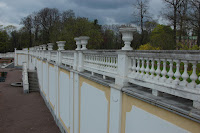For this exercise I was supposed to experiment with different ISO sensitivity levels.
I wanted to use different kinds of composition for this, from movement to very static ones to see, where the effect from changing the ISO sensitivity level would be more justified.
At first I went to the local football team game to experiment with moving objects. A first I took over 20 shots at ISO 200. I could only pick up two that were sharp enough. Though, I must admit that in both cases the players were not moving too fast.
I wanted to use different kinds of composition for this, from movement to very static ones to see, where the effect from changing the ISO sensitivity level would be more justified.
At first I went to the local football team game to experiment with moving objects. A first I took over 20 shots at ISO 200. I could only pick up two that were sharp enough. Though, I must admit that in both cases the players were not moving too fast.
185mm; f/9.0; 1/320 sec
100mm; f/9.0; 1/250 sec
And the pictures that could be more interesting from compositional perspective, are all not sharp, like the ones below:
130mm; f/9.0; 1/250 sec
170mm; f/9.0; 1/250 sec
I decided to keep aperture at f/9.0, as it gave the best option for taking close pictures as well as quickly moving back to more general views and maintain reasonable depth of field.
Then I changed ISO to 400. In this case the faster shutter speed increased the number of sharp images and allowed me take more interesting images. The shutter speed increased from 1/320 sec to 1/500sec.
250mm; f/9.0; 1/500 sec
220mm; f/9; 1/500 sec
However, for some of the shots, like the one below, 1/500 sec was still not fast enough.
220mm; f/9.0; 1/500 sec
The best shots I got at ISO 800. Quite a few images were sharp enough. And I had a better choice of compositions afterwards. I could freeze some movements that were quite fast, but of course at a cost of higher noise level on the picture.
220mm; f/9.0; 1/1000 sec
230mm; f/9.0; 1/1000 sec
However, considering that there are many moving objects on the pictures and the main goal was to catch interesting moments of the game and movements of the players, I think that in this case using higher ISO sensitivity is justified.
As a second part of the experiment I wanted to try some landscape images. For this I went to the sea to take some shots of sundown. As I was using tripod anyway, I was free in choosing smaller aperture of f/16.0. It might be that I could have used even smaller one...
38mm; f/16; 1/80sec
Then I changed to ISO 400, which resulted in shutter speed of 1/250 and of course increased th edigital noise on the image.
38mm; f/16.0; 1/160 sec
And my last shat was taken at ISO 800, which increased shutter speed to 1/250sec.
38mm; f/16.0; 1/250 sec
In this case using higher ISO is not really necessary. I was shooting using tripod and the scene itself is quite static. So, there was no need in capturing fast-moving object. In this case the only difference I got was higher level of noise with higher ISO.
And the third part of experiment was to take some shots of trees at a windy weather to see at what ISO it would be possible to freeze the movement of the leaves. Also, it was quite late in the evening and I had to use tripod and slower shutter speed anyway.
With lowest ISO 200 I could not make the image sharp enough, as the shutter speed was 1/10 sec and the movement of leaves was too obvious. Also, though camera was on tripod, it seems that the shot is not sharp enough not only because of the wind, but because I could not press the button smooth and right to use longer shutter speed.
220mm; f/16.0; 1/10 sec
Then I changed to ISO 400, which won me another 1/10 sec of shutter speed.
220mm; f/16.0; 1/20 sec
And my third trial was at ISO 800. The movement was captured the best in this case.
220m; f.16.0; 1/40 sec
In this case I would stick to the ISO 400, which does not create too much digital noise and helps to freeze the movement a bit better.
The major conclusion of the exercise would be that the one should always look, what image will be showing. If it is something static, like landscape, there is no point in sacrificing nice smooth background for the sake of faster shutter speed. But if the movement us exactly what photographer wants to show, then ISO is a good tool to use for capturing the most interesting moments.


















































